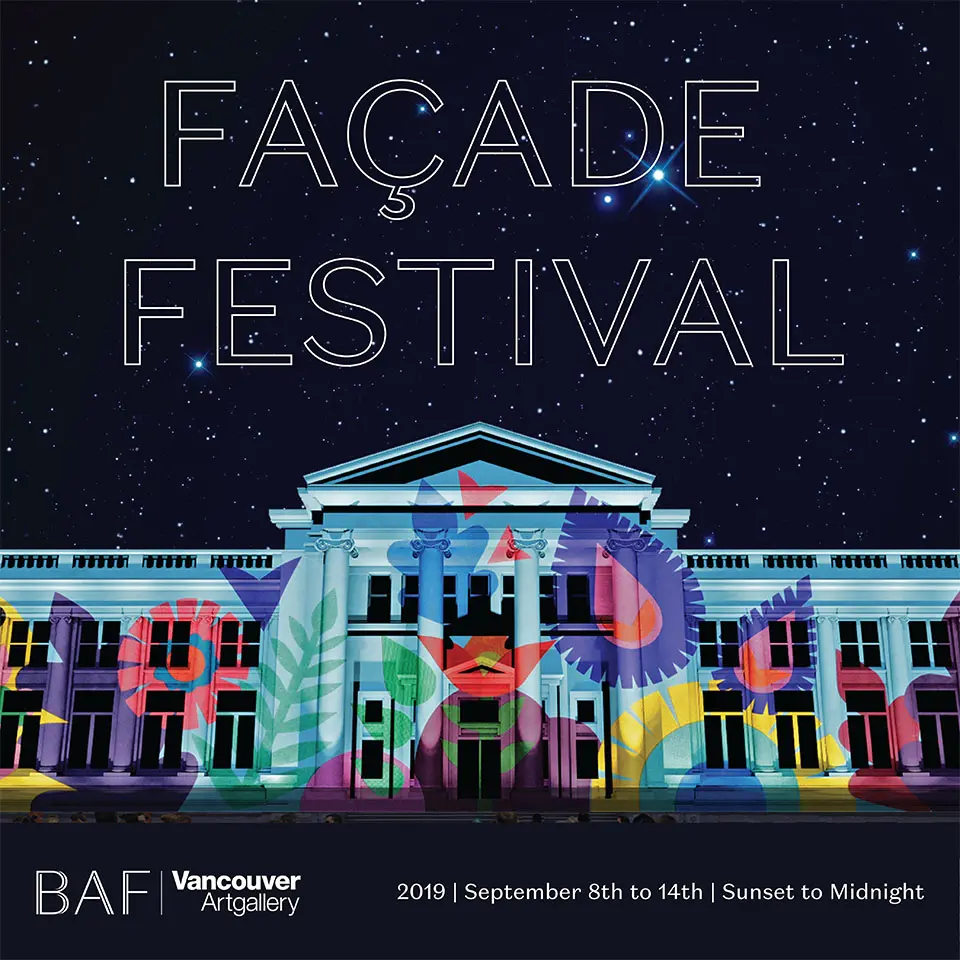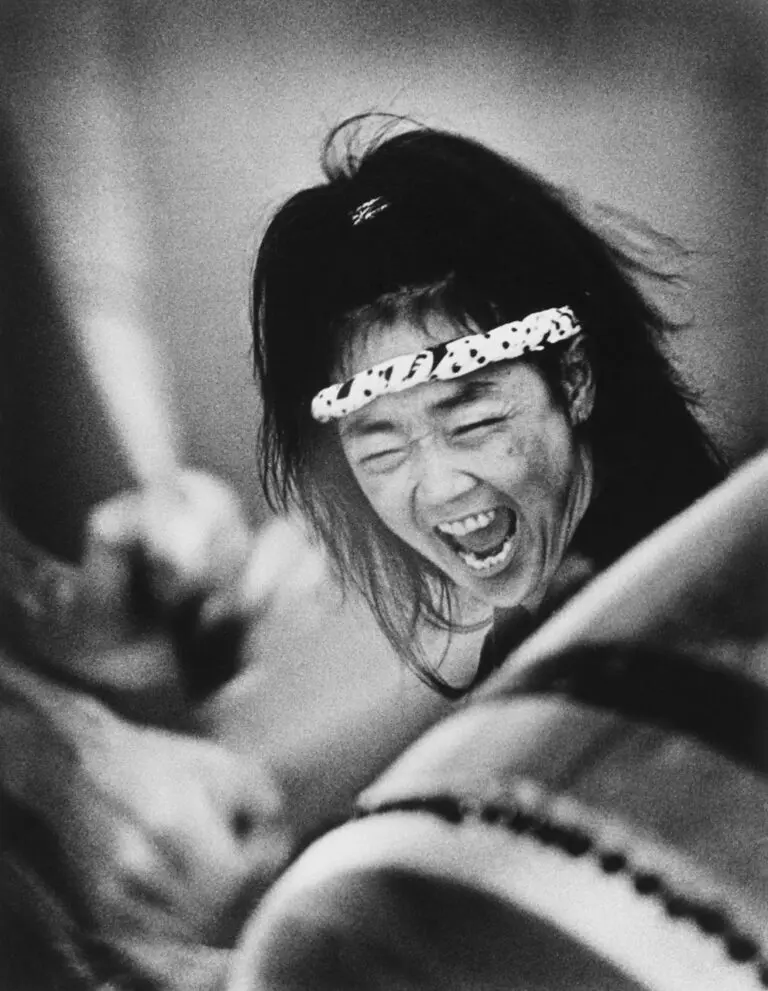Façade Festival 2019
Bracken Hanuse Corlett + Justine Chambers/Josh Hite
Wed Sep 11–Thu Sep 12, 2019 | 7:30 PM–12 AM

Façade Festival is a week-long, monumental public art project and cultural event that takes place from sunset to midnight every evening from September 8 to 14 on the Georgia Street façade of the Vancouver Art Gallery, above the šxʷƛ̓ənəq Xwtl’e7énk Square.
A selection of BC contemporary artists have been commissioned to create 10 stunning, site-specific works of art. Using the technology known as ‘projection mapping,’ the works have been tailored specifically for the Vancouver Art Gallery’s iconic architecture and will be projected over its Georgia Street façade, covering the building with moving, dynamic artwork. Façade Festival is an immersive, large-scale artistic experience that will be shared by tens of thousands of attendees.
The project speaks to the pervasiveness of digital forms in modern life and contemplates the role that new technologies play in contemporary art, while engaging the public in a grand architectural intervention free of charge.
Façade Festival is presented in partnership between Burrard Arts Foundation, the Vancouver Art Gallery, and technical partner Go2 Productions, with support from the City of Vancouver, the Department of Canadian Heritage, QuadReal Property Group, Tourism Vancouver, Viva Vancouver, Can Design, the Downtown Vancouver Business Improvement Association, and Savoury City Catering & Events.
WEDNESDAY SEPTEMBER 11
BRACKEN HANUSE CORLETT + JUSTINE CHAMBERS/JOSH HITE
BRACKEN HANUSE CORLETT
ABOUT THE PROJECT: “We SEE Monsters” is a short animation that begins with a skipper and a fisherman out at sea. One is focused on the moon, and the other remains intent on the water. Then, we abruptly leave this world and dive deep into the realms below, where monsters are the conductors of ceremony. Hanuse Corlett has been exploring the stories from his territories that feature monsters. Throughout these stories, the monsters are not static characters that reflect only good or evil; they project dynamic qualities and balance. Their narratives often meander and sometimes end abruptly or spill over into another story. Movement is also an important aspect of these stories, as the characters are often travelling, journeying and dancing. As Hanuse Corlett explains, movement is expressed in our formline designs. Our shapes depict bodies in motion. In our dances, we embody and enact the spirit of these beings.
“We SEE Monsters” features illustrations by Bracken Hanuse Corlett and Dean Hunt. The sound was created by Hunt in part by using field recordings from his home territory. Hunt comes from the Heiltsuk Nation and Hanuse Corlett comes from the Wukinuxv and Klahoose Nations. They have been working as an audio-visual duo since 2011, currently as the See Monsters and previously as part of Skookum Sound System. Hanuse Corlett also trained in the aspects of Northwest Coast Art, design and carving with Hunt, his brother Shawn Hunt and father Bradley Hunt. These illustrations were digitized by Hanuse Corlett, and then animated by Keith Morgan and Amanda Strong from Spotted Fawn Productions. Additional sound design and foley were created by Troy Slocum. This animation was made with the support of BC Arts Council and Canada Council for the Arts.
ABOUT THE ARTIST: Bracken Hanuse Corlett is an interdisciplinary artist hailing from the Wuikinuxv and Klahoose Nations. He began working in theatre and performance in 2OO1 and eventually transitioned towards his current practice that fuses painting and drawing with digital-media, audio-visual performance, animation and narrative. He is a graduate of the En’owkin Centre of Indigenous Art and went to Emily Carr University of Art and Design for Visual Arts. He has studied Northwest Coast art, carving and design from acclaimed Heiltsuk artists Bradley Hunt and his sons Shawn Hunt and Dean Hunt. He was a recipient of the 2O14 BC Creative Achievement Award for Aboriginal Art and has recently received public art commissions from the City of Vancouver and the City of Victoria. He splits time between the confines of his studio in the Downtown Eastside and his home on the Sunshine Coast. Some of his notable exhibitions, performances and screenings have been at Grunt Gallery, Museum of Anthropology, Unit PITT Projects, Vancouver International Film Festival, Vancouver Art Gallery (FUSE), Institute of Modern Art – Brisbane, Three Walls Gallery – Chicago, Paramount Theater – Seattle, Ottawa International Animation Festival, SAW Gallery, Royal BC Museum, Open Space, Winnipeg Art Gallery, Urban Shaman, Mackenzie Art Gallery, ImagineNative and Toronto International Film Festival.
JUSTINE CHAMBERS AND JOSH HITE
ABOUT THE PROJECT: Justine Chambers and Josh Hite’s Facade Festival 2019 project “Sectional Elevations” borrows its title from architecture. The work denotes vertical slices of a building, making multiple interior spaces visible simultaneously. To create this work, Chambers and Hite photographed every north facing wall within the projection envelope of the Vancouver Art Gallery, then set up a parallel relationship between physical and virtual space as it moves south, and an oppositional alignment as it moves north. The images are always progressing toward a singular vertical wall shared by all spaces in the building, meaning that, as all the images move simultaneously, the viewer is observing the representation of a singular plane within the entire Vancouver Art Gallery building.
ABOUT JUSTINE CHAMBERS: Justine A. Chambers is a dance artist living and working on the unceded territories of the Sḵwx̱wú7mesh, Musqueam and Tsleil-Waututh Nations. In her work, she privileges what is felt over what is seen by working with her body as an imperfect recording device to develop a cumulative embodied archive. Chambers’ interests are in re-imagining dance performance and activating the dances that are already there—the social choreographies present in the everyday. Chambers is Max-Tyler Hite’s mother.
ABOUT JOSH HITE: Josh Hite works with video, animation, sound, performance and photography, often creating reorganized archives of particular spaces, objects, or behaviors. His practice leans towards an ethnography that acknowledges content and tactics for documentation as determinants of eventual form, rather than relying on art historical or cultural references as structural assistants. Projects tend to query relationships between an experience and its location, the power dynamics at play, and the ways in which transitions and sequencing can seamlessly propel us through time.
